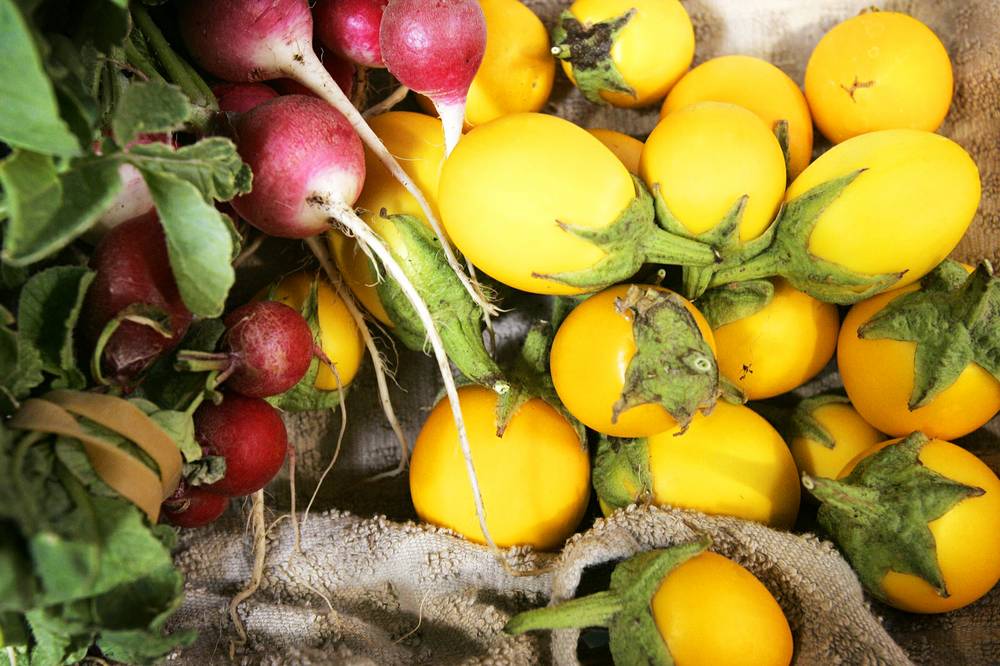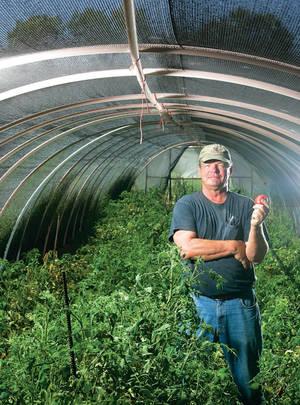“Have you ever picked leeks before?” Jesse Scott asks without a hint of irony. He reaches down and wraps a wide hand around the base of a plant with floppy greens sprouting from its stem. In one fluid motion he pulls the vegetable from the ground. Scott’s leeks are the size of sausages.
Yes, you can grow food here. Good food. Good enough to be served in some of the Strip’s best restaurants. You look outside your window and you see palm trees and cacti, but closer than you think, local farmers are raising crops you’d swear were imported from California or the Midwest. We may live in a desert, but Southern Nevada is no wasteland.
Scott is the manager of Buckhorn Ranch in Alamo, Nevada, about 90 minutes from the Strip. Scott raises a herd of 1,000 goats and farms eight acres of vegetables and fruit in what he calls the ranch’s “garden.” Along with the leeks, there are tomatoes, asparagus, peppers, cantaloupe and watermelon. Garlic and onions are nestled into the soil, which spreads across the plot in a rich, earthy brown.
Just five years ago, Buckhorn was a faltering cattle ranch and Scott was a refrigerator technician in Palm Springs, California. Asked by a friend to take over the property, he turned the 125-acre ranch into a goat and vegetable farm good enough to be tapped by Mario Batali. Every week, Buckhorn sells 400-600 pounds of fresh produce to B&B Ristorante, Carnevino and Enoteca San Marco, and every week, Batali’s chefs craft pitch-perfect Italian flavors from produce grown right here in Southern Nevada. Though it seems counter-intuitive, tiny corners of Vegas’ biggest casinos are driving a local agriculture movement on the verge of taking off.
The idea that food can be grown locally wasn’t always so strange. “Up until the 1950s, there was a substantial amount of fruits and vegetables being grown in the valley,” says Bob Morris, the horticulturist and associate professor who runs the University of Nevada Cooperative Extension Orchard in North Las Vegas.
On the outer edge of the Vegas map, Morris makes a living learning what will grow and how to grow it. The one-acre orchard is a cornucopia of products and production methods. In one row, you’ll find different varieties of peaches, in another apples or apricots. Further along are asparagus, tomatoes and 16 kinds of wine grapes. Though Morris sells produce to Mario Batali and Alex Stratta’s restaurants, off-Strip landmarks like Rosemary’s and Nora’s Wine Bar and local consumers, the facility is primarily intended to be educational. “Our objective is not to make money,” Morris explains. Rather, the facility is for “testing, evaluation and research.”
That research, in turn, is passed along to local farmers who don’t have the luxury of growing flops. In Scott’s first year tending a plot at Buckhorn Ranch, nothing, literally, would grow. This year, using covered hoop houses, Scott’s tomato plants have been healthier and put out more fruit. “It’s a slow process,” he says, “but we’re pleased with the progress.” And Scott’s not the only one. “A year ago they would only grow their thing,” Doug Taylor, executive pastry chef for Mario Batali’s Las Vegas restaurants, says of the local farmers. Now, he adds, “these guys are growing by 90 percent.”
But growing in Southern Nevada, with its brutally hot summers and scarce, expensive water, is only half the challenge for local farmers. Sometimes, the hardest part is figuring out how to bring carefully raised fruits and vegetables from the farm to the table.
“Until recently, nobody knew produce was available locally,” says Taylor, who includes himself in that category. A Nor-Cal transplant, he arrived in Vegas a few years ago imagining a barren stretch of desert with an adult amusement park in the middle. At first, that’s exactly what he found.
“To go from Northern California, the largest farmland in the world, to where there was nothing … it was truly depressing.” Like most chefs, he began working with the large national suppliers that truck in most of the food that ends up on Strip tables. “I was so unhappy with the product I was getting,” Taylor says. “It’s not their fault; they have to supply a demand. But for our guests, that’s not okay.” For restaurants like Batali’s, produce that ripens on trucks or in crates just isn’t up to standard. “Mario wants a really intense flavor,” Scott explains. “He can’t get that flavor from supermarket products. Where you get it is from the local farmer.”
More
And Buckhorn Ranch gets plenty from Batali, too. Scott not only sells fruits and vegetables to Batali’s chefs, he also recycles their waste. Every week, he hauls away almost 500 gallons of kitchen trimmings from the restaurants and composts them to create the rich soil that allows him to grow in his eight-acre garden. “The compost is the heart,” Scott says. “Our desert soil is basically dead. You’ve got to create the environment.”
Along with potato peelings and fruit rinds, he takes 200-300 gallons of used cooking oil that would otherwise go to waste each week and processes it back in Alamo. In a small shed on the ranch, the oil is strained, heated and flushed with water as it moves through a series of vats. Fats, called triglycerides, are drawn out and used to seal the dirt roads that wind through Buckhorn Ranch. After being cleaned in various stages, the oil runs clear and yellow, transformed into biodiesel that Scott uses to power his farm equipment.
Ninety-six miles away, Taylor leads me through the maze of kitchens that connect Batali’s Strip restaurants. At one station, a cook prepares ravioli, one of 26 varieties of pasta the kitchen makes fresh. At another, a cook makes gelato, some of which may be flavored with vibrant peppermint grown just outside town. In a nearby fridge, a bucket full of almonds on the stem from 15-acre King Ranch in White Hills, Arizona, slowly becomes house-made amaretto, and further along, sit bottles of grappa with fully grown fruit inside them, an experiment from Morris’ orchard—bottles are affixed to trees when fruit is very young and allowed to mature inside the glass.
About three years ago, Taylor started looking into local producers, trying to track down sources for fresh-from-the-farm products he’d grown so accustomed to in California. With Batali’s blessing, he started with working with one farm. Today, Taylor and the other chefs from Batali work with 56 local growers. “When we first started it was like, ‘What are you guys doing?’” he says of the Venetian-Palazzo brass’ reaction to his partnership with local growers. Gradually, as they’ve seen the quality of the produce—and that it will sell—they’ve come around, he says.
Besides using the local produce in his own kitchen, Taylor has dedicated himself to being the vital bridge between area farmers and Strip chefs. “Las Vegas spends $1.5 billion a year on produce and agriculture,” he explains. “If we can capture one or two percent of that, it could change the whole community.” But keeping the money in the community isn’t easy. Unlike restaurants in most cities, many of Vegas’ high-end kitchens are housed somewhere in the maze of a casino’s back-of-house. A farmer can’t simply knock on the door and show a chef his wares. He needs to know his way in, and he needs to know his way around the system.
“There’s a big hurdle with buying locally, and Strip restaurants, many of them have to buy through the casino,” explains Morris. “You have to then become a vendor for the casino. You have to deliver through this massive back door.” Becoming a casino vendor is also extremely difficult. “You have to carry $1 million of liability insurance,” Morris continues. “You have to submit billing, and it’s 30-90 days before you get paid. For a small-scale local producer, that’s a long time.”
The other hurdle keeping local growers out of most Strip kitchens is price. “Many restaurants have a price point that may not allow them to just sub local foods for what they’re already buying,” Morris says. It’s the Strip’s top-tier eateries that can and do splurge on locally grown, fresh-picked produce, passing any bump in cost on to customers who willingly pay for the quality they demand.
The University of Nevada Cooperative Extension’s Producer to Chef program is about connecting small-scale producers like Scott directly to the Strip’s big-time chefs and matching needs. When things work well, the chefs get the high-quality produce they want for their guests, and farmers find a market for locally grown food that’s often more expensive than the stuff arriving from out of town. Taylor works for the program on the side, helping make valuable introductions that can lead to relationships out-of-town suppliers and chefs would never have.
Such relationships are evident in a warehouse on Dean Martin Road. Every Thursday, a portion of Mario Batali’s dry-aging facility is transformed into the Molto Vegas farmers market (7485 S. Dean Martin Drive, Suite 106, 11 a.m.-1 p.m.), which showcases products from Southern Nevada and just beyond. Before it opens to the public, the market delivers to about 20 local restaurants, including Shawn McClain’s Sage at Aria and the Palms’ Nove Italiano. At 11 a.m., the Molto market opens its doors to the public, and over the course of the next two hours nearly 700 people trickle through, buying dates, peppers, herbs, melons, fresh tomatoes and much more, some of it picked that morning. Often, chefs stop by just to talk to farmers and check out their wares. The space is donated. Entry is free. The vibe is friendly and optimistic.
Though Jesse Scott and Buckhorn Ranch sell between $400-$800 worth of produce every week at the market, often to the same customers who return again and again, it’s their relationship with Taylor that keeps the farmer planting new products and experimenting with an orchard that should be producing apples at this time next fall. During Scott’s first year working with Taylor and Mario Batali’s restaurants, the rancher was only growing squash. “He grew hundreds of pounds of squash a week,” laughs Taylor. “We had to find ways to use it all.”
Of course, Taylor could have said no thank you to Scott’s surplus squash, but the relationship between the local producers and the Strip chefs who buy from them goes beyond basic business dealings. Farming isn’t a normal business, after all. “If you don’t sell your product, you can’t put it back on the shelf,” Taylor says. In some cases, chefs even get the chance to order before the planting season, making requests for a specific breed of pumpkin and coaching the farmers to raise the product they want to buy. They may pay extra for that tomato, but they know it’s going to be good, and all of that money goes straight back into the farm. As the demand for and value of locally grown food has skyrocketed, a symbiosis has developed between the Strip and its local suppliers.
Of course, certain realities of life in the desert cannot be ignored. Las Vegas and Southern Nevada will never be a self-sustained agricultural community. Some products are just too thirsty, and we’ll never be able to stock RM Seafood with fresh-from-Lake-Mead seafood or fish. However, with every growing season, more local farmers are learning what it takes to grow restaurant-quality produce in the desert, and restaurants like B&B, Nove and Sage are seeing success using locally grown fruits and vegetables. As the locavore moment that has swept the nation reaches a crescendo in Vegas, perhaps the casinos will heed its call. And someday, you may be able to sit down for dinner at any high-end Strip restaurant, bite into a juicy wedge of tomato and know it was grown right here in Southern Nevada.



Previous Discussion: